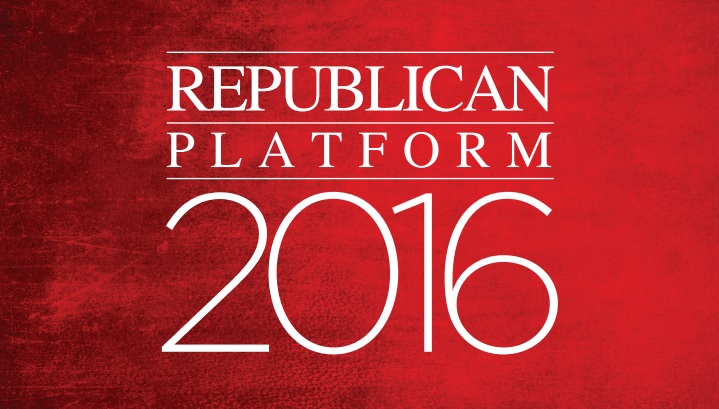Kate Davidson in The Wall Street Journal recently took note of a GOP 2016 plank that had been largely overlooked in all the focus on the social issues in the Platform Committee: “GOP Platform Includes Proposal to Study Return to Gold Standard.”
The Republican Party’s 2016 platform calls for a commission to explore the feasibility of effectively returning the U.S. to a gold standard.
The idea has been popular with parts of the GOP for years, but hasn’t gone very far.
The new platform, approved at the party’s convention Monday, echoes similar language in the 2012 GOP platform by calling for a commission to “investigate possible ways to set a fixed value for the dollar.”
[…]
The party platform isn’t binding on the president or other elected GOP officials, but reflects the thinking of many party activists.
Several Republican presidential primary candidates expressed support or interest in the idea during the campaign. Sen. Ted Cruz of Texas reiterated his support for returning to the gold standard in a debate last November. Sen. Rand Paul of Kentucky said the idea should be studied. Neurosurgeon Ben Carson alluded to the idea, saying, “We’ll have to tie our currency to something,” while former Arkansas Gov. Mike Huckabee advised, “Tie the dollar to something fixed and if it’s not going to be gold, make it the commodity basket.”
To which could, and surely should, be added nominee Donald Trump’s two glowing public statements on the gold standard and the vice presidential nominee Mike Pence forward-leaning statements, when a prominent member of Congress, about the gold standard.
There are two worthwhile quibbles to be had with The Wall Street Journal‘s otherwise good scoop, which also observes:
To supporters, part of the appeal of a gold standard is that it makes sustained inflation impossible. However, the U.S. experienced multiple financial crises and recessions while on the gold standard, and many historians say it played a central role in causing the Great Depression. The U.S. went off the gold standard in the 1930s.
First, there is a subtle but extremely significant distinction between the 2012 Platform’s call for better monetary integrity, which indeed then was explicitly tied (with some legitimacy) to concerns about potential inflation and the 2016 Platform’s call. The comparable 2016 plank differs in that it is not predicated on making “sustained inflation impossible.” The 2016 plank’s address of monetary integrity is predicated, rather, on, “job creation, upward mobility for workers, and equitable prosperity….”
The platform is very much in alignment with matters we have emphasized, repeatedly, here, most recently in “A Letter To The Left: The Gold Standard Will Restore Upward Mobility.” The GOP’s emphasis on equitable prosperity is a breakthrough — both in terms of voter appeal and in terms of moral high ground. This distinction deserves to be correctly reported and duly emphasized. The GOP Platform Committee, and the full GOP Convention, which adopted it, deserves high praise for adopting this plank.
Second, the much recycled claim that the U.S. experienced “multiple financial crises and recessions while on the gold standard” overlooks the pretty obvious fact that the U.S. has experienced multiple financial crises and recessions while on the Federal Reserve Note standard ushered in by President Nixon in 1971. In fact, the Bank of England published a rigorous and important white paper in 2011, Financial Stability Paper No. 13. Its findings?
The U.S. has experienced far more and far worse financial crises and recessions (and other problems) since going off the gold standard, neatly and strikingly summarized by Forbes.com columnist Charles Kadlec shortly thereafter. There’s much to be said for people who live in glass houses shouldn’t throw stones. Our elite prestige academic economists should take this to heart.
Moreover, although it is conventional to say so, in fact the U.S. did not go “off the gold standard in the 1930s.” As I recently wrote at Forbes.com:
In 1922, it was replaced, in the immortal words of the great French economist Jacques Rueff, by a “grotesque caricature.”
The Economist described that system, quite correctly, as “a mess.” It called itself a gold standard without playing by the rules of the gold standard. The Interwar so-called “gold standard” was a hybrid between Jabberwocky and Calvinball. The true gold standard was but a dim memory by the onset of the Great Depression for which it was framed. The misguided fixation of “many economists” – deluded by the Eichengreen Fallacy — on the role of “the” gold standard in worsening the Great Depression is contradicted by history.
Bottom line.
Kudos to Kate Davidson for having scooped the competition by taking note of the 2016 GOP’s call for a “commission to investigate ways to set a fixed value for the dollar.” Superior reporting! That very commission, as duly noted in the plank, under Republican Leadership — most notably, although not exclusively, Reps. Kevin Brady, Jeb Hensarling, Paul Ryan, Scott Garrett and Bill Huizenga — was passed by the full House and now is pending in the U.S. Senate, which the 2016 GOP platform has called upon to enact it.
Kudos to the Republican Party for demanding a better, higher integrity, standard for the dollar than has been in evidence for over 40 years and under both parties. Restoring the integrity of our national unit of account is fundamental to the restoration of a climate of equitable prosperity and, thus, to making America great again.
Ralph Benko, internationally published weekly columnist, co-author of The 21st Century Gold Standard, lead co-editor of the Gerald Malsbary translation from Latin to English of Copernicus’s Essay on Money, is American Principles Project’s Senior Advisor, Economics.


